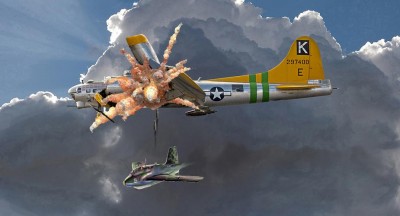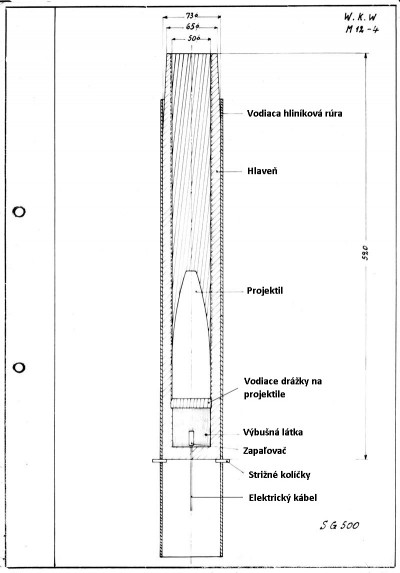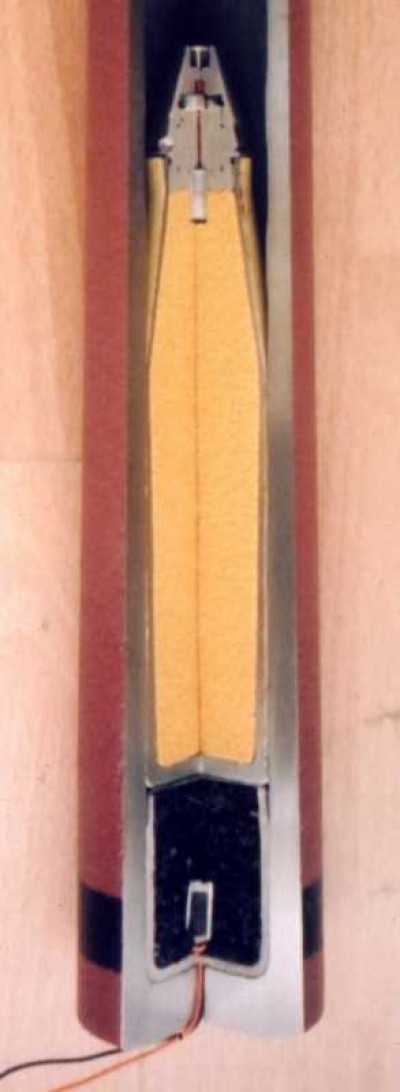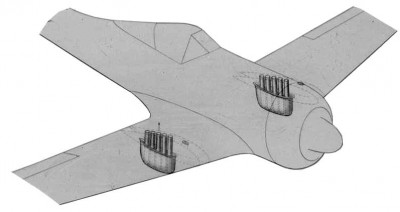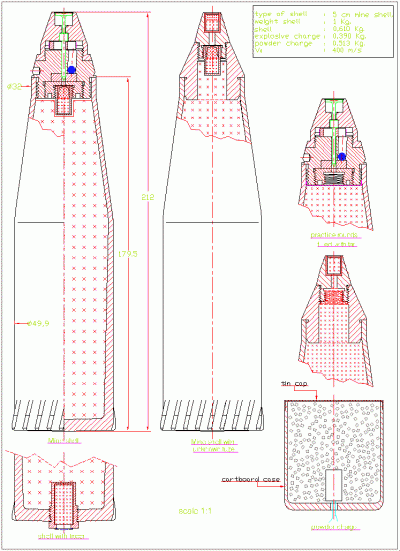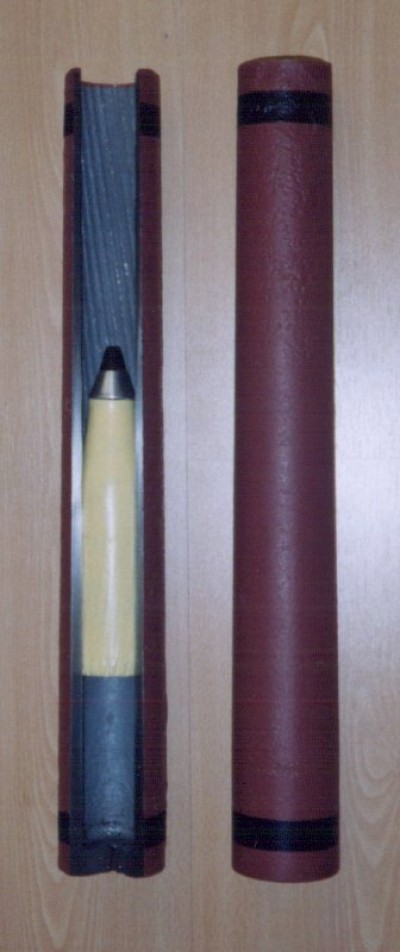| Title: Name: | Sondergerät SG 500 Jägerfaust | Sondergerät SG 500 Jägerfaust |
| Original title: Original Name: | Sondergerät SG 500 Jägerfaust | |
| Manufacturer: Producer: | Hugo und Alfred Schneider AG (HASAG) | |
| Period of production: Production Period: | DD.MM.1944-DD.MM.1945 | |
| Made pieces: Number of Produced: | ? | |
| a Prototype made: Prototype Built: | DD.MM.1944 | |
| Use: Use: | Messerschmitt Me 163 B-1 Focke Wulf FW-190 | |
| Technical data: Technical Data: | ||
| Weight: Weight: | 6.9 kg | 15 lb |
| Caliber: Calibre: | 50 mm | |
| Charge: Cartridge: | 50x212 mm | |
| barrel Length: Barrel Length: | 520 mm | 1ft 8,46 in |
| Overall length: Overall Length: | 648 mm | 2 ft of 1.51 in |
| Used ammunition: Ammo Used: | Minengranate kal. 50 mm | Minengranate kal. 50 mm |
| Feats: Performance: | ||
| Maximum range: Maximum Range: | 0.1 km | 0.1 I |
| Rate of fire: Rate of Fire: | 1 1) r/min | 1 1) rpm |
| Muzzle velocity: Muzzle Velocity: | 400 m/s | 1312.3 ft/s |
| Note: Note: | 1) weapon bola jednovýstrelová | 1) single shot gun |
| Source: Sources: | Hahn, F.: Waffen und Geheimwaffen des Deutschen Heeres 1933-1945, Dörfler-Verlag King, J.B., Batchelor, J.: German Secret Weapons, BPC Publishing (UK), 1974. www.deutscheluftwaffe.de robdebie.home.xs4all.nl | |
Sondergerät SG 500 Jägerfaust
Sondergerät SG 500 Jägerfaust (fighter fist) was the designation of the German single-shot recoilless cal. 50 mm developed by Hugo und Alfred Schneider AG (HASAG) to be fitted to Fw 190, Messerschmitt Me 163 B-1 and Me 262 fighters. The peculiarity of this, inherently recoilless gun was that when the ejection charge was fired and the projectile was fired towards the aircraft, the entire barrel was ejected in the opposite direction, i.e. downwards. The barrel was rifled and the projectile was thus stabilized in flight by rotation. The SG 500 has only been realistically tested on Fw 190 and Messerschmitt Me 163 B-1, and has only been successfully deployed in combat in one known case on the latter aircraft.
Each of the aircraft had 10 barrels installed, five bundles in each wing, with the barrels pointed vertically upwards. Combat use was as follows: the pilot guided the aircraft no more than 100 m below the enemy bomber and activated an electro-optical launcher located in front of the radio antenna. When the bomber was underflying, its shadow activated a photocell, which electrically fired a projectile which subsequently hit the enemy aircraft. The live firing of the weapon mounted on the Me 163 was first tried by Leutnant Gustav Hachtel, pilot of the Jagdgeschwader 400. The first trials consisted of attacks on tethered barrage balloons, which he successfully destroyed. Later, tall structures were erected on the test range with practice targets under which he was to fly at a minimum height above the ground. Tests with the FW-190 and with pilot-fired missiles went without problems, but the danger was from the barrels, which, when fired, bounced off the ground up to the height of the flying machine. Therefore, testing on this type of aircraft was abandoned and tests were only conducted on the Me 163. This was first attempted by Leutnant Hachtel on 24.12.1944. At an altitude of 300 m he activated the electro-optical launcher, but unexpectedly all rockets were fired simultaneously. The pressure wave after the shot tore off the cockpit overlap and Hachtel had to make an emergency landing. The machine suffered serious damage and had to be scrapped, the pilot suffering a spinal injury. The cause of the premature launch was the setting of the electro-optical trigger too high, which was activated by the shadow of a cloud over the target. After adjustments, the tests continued, with the participation of Leutnant Fritz Kelb, who later succeeded in shooting down a Me 163 bomber on April 10, 1945 with Halifax armed with an SG 500. In total, about twelve Me 163 B-1s were equipped with the Jägerfaust. However, even these "miracle weapons" could no longer avert the fall of the Third Reich.
From a technical point of view, the Sondergerät SG 500 Jägerfaust was a single-shot recoilless gun. The barrel consisted of a grooved thick-walled tube, closed at the bottom. At its bottom was placed Zündpille S x 5/500, which was a compressed explosive substance weighing 500 g placed in a 50 mm long paper cylinder. It was detonated by a detonator activated electrically by a cable passing through a small hole in the bottom of the barrel. The projectile had a length of 226 mm and a total weight of 1,130 kg, of which 0,617 kg was the weight of the projectile and 0,390 kg the weight of the explosive charge. A contact impact fuze was screwed into the front of the projectile. In order to insert the projectile into the rifled barrel, notches corresponding to the dimensions of the grooves were milled in the lower part of the projectile. The barrel itself was housed in a thin aluminum guide tube attached to the wing of the aircraft, at the bottom of which were two shear pins holding the barrel in flight. The recoil after the shot pushed on the barrel, which sheared off the two pins and was ejected under the aircraft.
Ransom, S., Cammann, H.-H.: Jagdgeschwader 400: Germany's Elite Rocket Fighters, Osprey, ISBN: 978-1846039751
Each of the aircraft had 10 barrels installed, five bundles in each wing, with the barrels pointed vertically upwards. Combat use was as follows: the pilot guided the aircraft no more than 100 m below the enemy bomber and activated an electro-optical launcher located in front of the radio antenna. When the bomber was underflying, its shadow activated a photocell, which electrically fired a projectile which subsequently hit the enemy aircraft. The live firing of the weapon mounted on the Me 163 was first tried by Leutnant Gustav Hachtel, pilot of the Jagdgeschwader 400. The first trials consisted of attacks on tethered barrage balloons, which he successfully destroyed. Later, tall structures were erected on the test range with practice targets under which he was to fly at a minimum height above the ground. Tests with the FW-190 and with pilot-fired missiles went without problems, but the danger was from the barrels, which, when fired, bounced off the ground up to the height of the flying machine. Therefore, testing on this type of aircraft was abandoned and tests were only conducted on the Me 163. This was first attempted by Leutnant Hachtel on 24.12.1944. At an altitude of 300 m he activated the electro-optical launcher, but unexpectedly all rockets were fired simultaneously. The pressure wave after the shot tore off the cockpit overlap and Hachtel had to make an emergency landing. The machine suffered serious damage and had to be scrapped, the pilot suffering a spinal injury. The cause of the premature launch was the setting of the electro-optical trigger too high, which was activated by the shadow of a cloud over the target. After adjustments, the tests continued, with the participation of Leutnant Fritz Kelb, who later succeeded in shooting down a Me 163 bomber on April 10, 1945 with Halifax armed with an SG 500. In total, about twelve Me 163 B-1s were equipped with the Jägerfaust. However, even these "miracle weapons" could no longer avert the fall of the Third Reich.
From a technical point of view, the Sondergerät SG 500 Jägerfaust was a single-shot recoilless gun. The barrel consisted of a grooved thick-walled tube, closed at the bottom. At its bottom was placed Zündpille S x 5/500, which was a compressed explosive substance weighing 500 g placed in a 50 mm long paper cylinder. It was detonated by a detonator activated electrically by a cable passing through a small hole in the bottom of the barrel. The projectile had a length of 226 mm and a total weight of 1,130 kg, of which 0,617 kg was the weight of the projectile and 0,390 kg the weight of the explosive charge. A contact impact fuze was screwed into the front of the projectile. In order to insert the projectile into the rifled barrel, notches corresponding to the dimensions of the grooves were milled in the lower part of the projectile. The barrel itself was housed in a thin aluminum guide tube attached to the wing of the aircraft, at the bottom of which were two shear pins holding the barrel in flight. The recoil after the shot pushed on the barrel, which sheared off the two pins and was ejected under the aircraft.
Ransom, S., Cammann, H.-H.: Jagdgeschwader 400: Germany's Elite Rocket Fighters, Osprey, ISBN: 978-1846039751
www.deutscheluftwaffe.de
www.zvlastnezbrane.estranky.sk
robdebie.home.xs4all.nl
Reklama
Join us
We believe that there are people with different interests and experiences who could contribute their knowledge and ideas. If you love military history and have experience in historical research, writing articles, editing text, moderating, creating images, graphics or videos, or simply have a desire to contribute to our unique system, you can join us and help us create content that will be interesting and beneficial to other readers.
Find out more